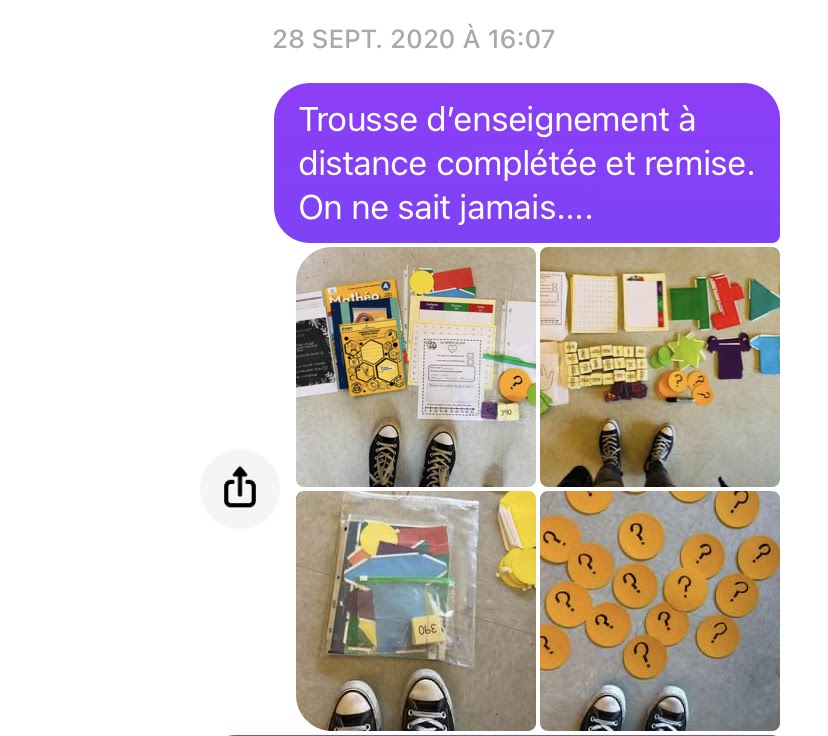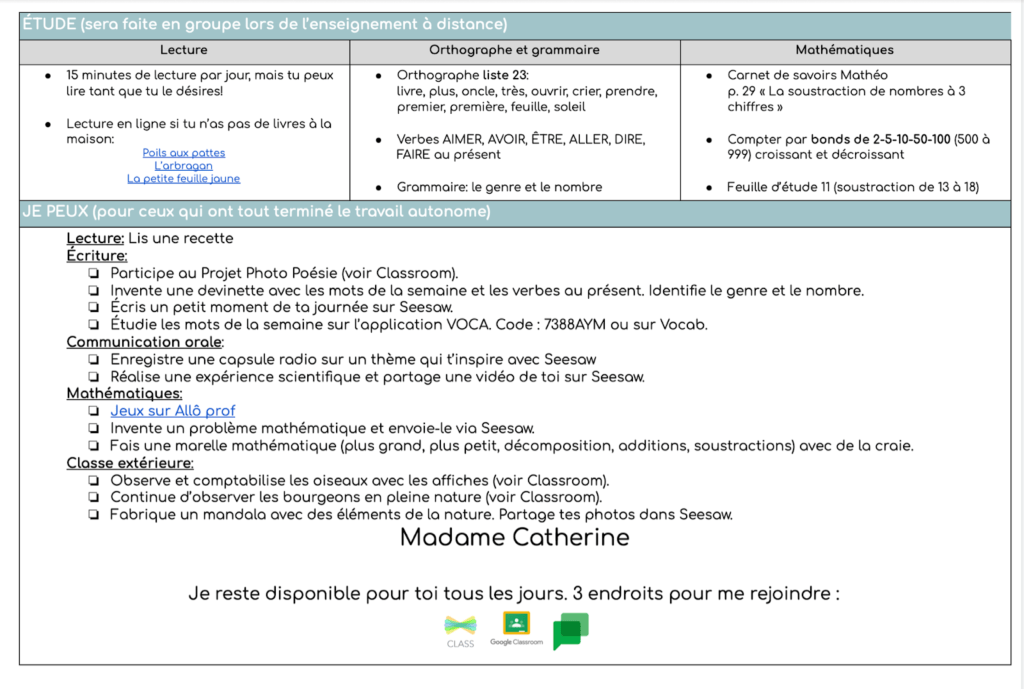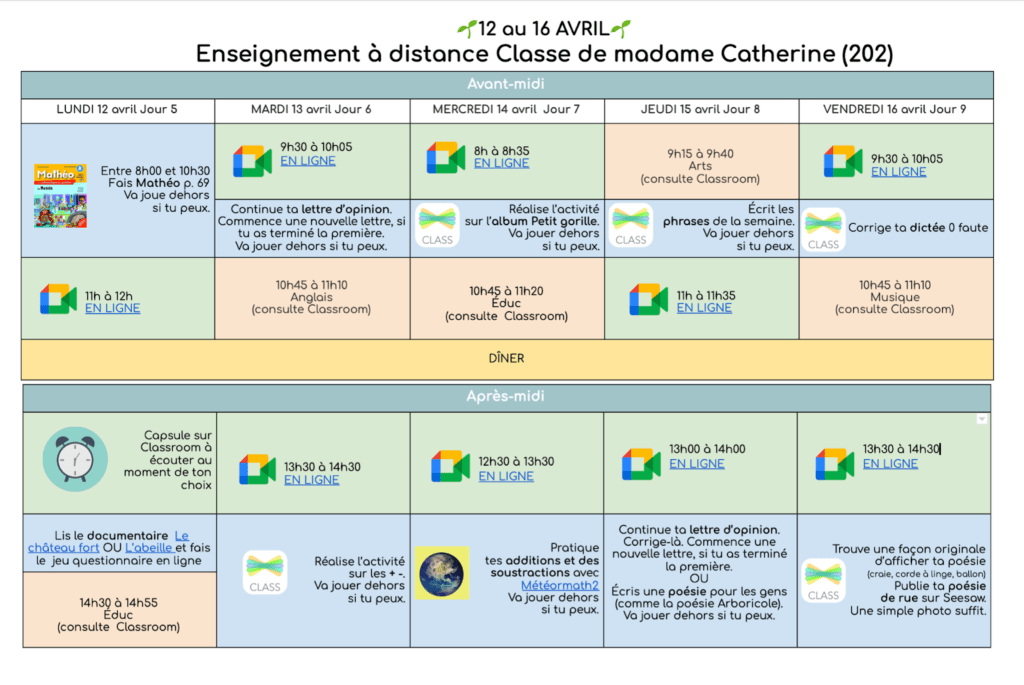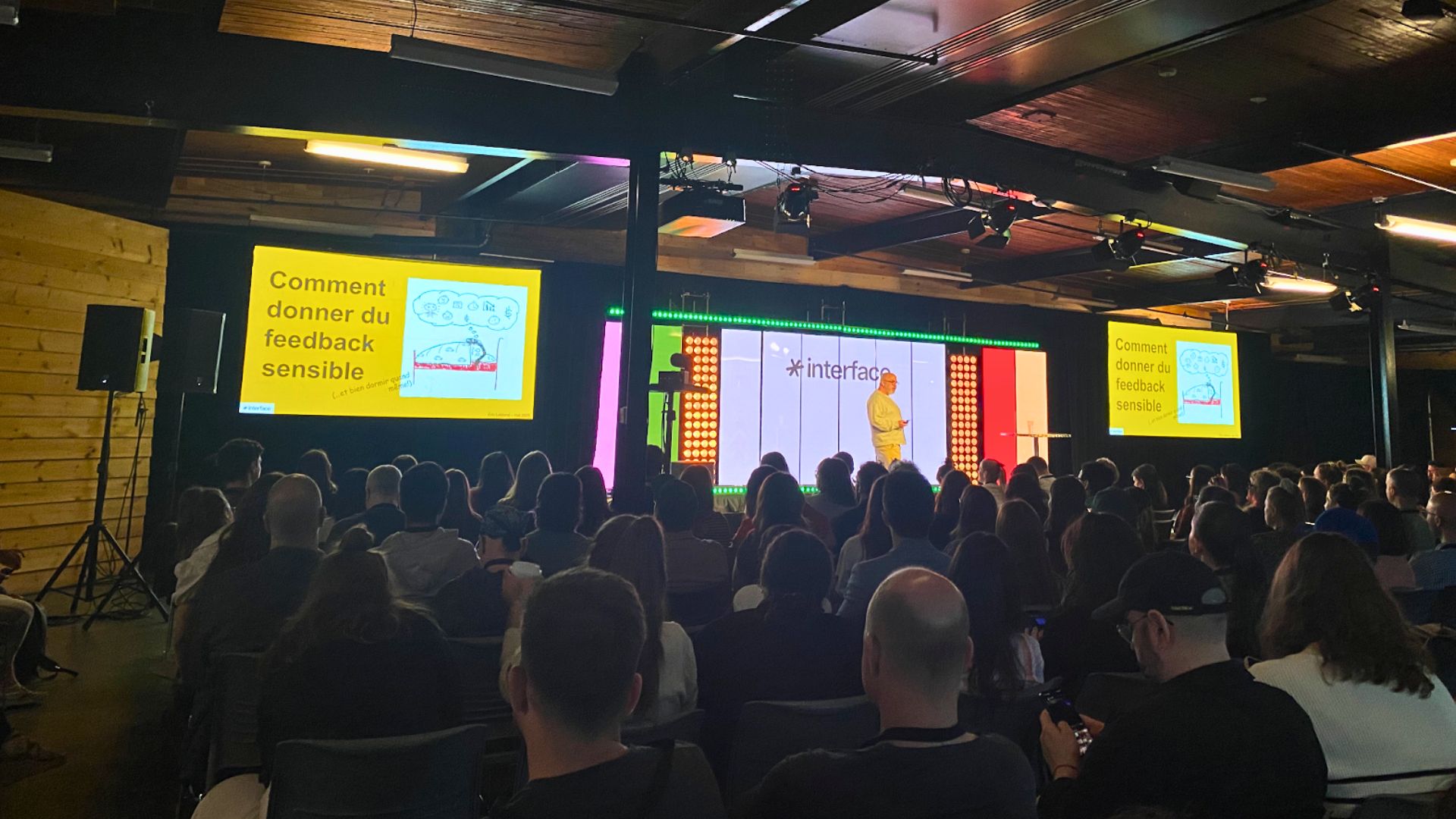Par Catherine Lapointe, avec la collaboration de Martine Rioux
L’enseignement à distance est un défi pour tous, mais la tâche est d’autant plus complexe avec les plus jeunes. Comment faire pour que la classe en ligne soit motivante, pour garder l’attention des élèves et rendre les apprentissages plus actifs et engageants? Deux enseignantes du primaire nous ont partagé leurs conseils. Dans un premier temps, voici ceux de Catherine Lapointe, enseignante en 2e année à l’école du Campanile (CSS des Découvreurs).
« Malgré tous les trucs qu’on peut mettre en place, rien ne remplacera l’enseignement en présentiel. L’enseignement en ligne est une pratique d’urgence dans un contexte pandémique. Ce n’est pas l’idéal. Ce n’est pas naturel. Ce n’est pas facile, ni pour les profs, ni pour les élèves, ni pour les parents. La motivation des élèves se fragilise partout quand l’effet de nouveauté disparaît. Il faut se réinventer constamment. J’ai quand même du plaisir à voir mes élèves. Je les trouve bons et engagés. Solidaires et positifs », tient à préciser Catherine.
Le maintien du lien = ESSENTIEL
- Permettre aux élèves d’arriver 5 minutes avant le temps. Ils clavardent, ils se présentent des jouets, des semences qui poussent, etc. C’est parfait pour maintenir un sentiment d’appartenance. C’est comme le 5 minutes avant que la cloche sonne. Cela permet aussi de commencer à l’heure pour optimiser le temps prévu pour l’enseignement, car on est dans les seuils minimaux alors on est loin des 5 h d’enseignement en classe.
- Accueillir les élèves en les saluant un à un. « On a un nouvel élève ce matin. Le chat de Margot! » « J’adore le cadre derrière toi Jules. » «Tu sembles endormi Milo. Ça va? »
- Exporter le climat de classe et rigoler. Les blagues ne sont pas accessoires pour démontrer notre plaisir à être avec eux et offrir un enseignement authentique. Une collègue s’est même déguisée en banane, d’autres ajoutent une journée thématique ou faux suppléant (se déguiser).
La classe en ligne
- Partager son écran pour aider les élèves à se situer. Afficher la date ou un calendrier avec le matériel à sortir 5 minutes avant l’heure du cours. Le support visuel reste essentiel, même si cela demande plus de planification et de temps.
- Faire bouger les élèves en épelant les mots de la semaine. Version active : Jumping mot, boxer les mots, la corde à danser. Version calme et non bruyante (pour les parents en télétravail ou les frères/soeurs en enseignement à distance en simultané) : juste taper doucement dans leur main ou tracer les lettres dans les airs.
- Faciliter la prise de parole. Avec les petits, l’option de lever la main avec le bouton de la main n’est pas facilitant (ils le cherchent, ils oublient de l’enlever). Prévoir un petit carton/pastille avec un point d’interrogation que les élèves peuvent montrer physiquement à l’écran lorsqu’ils veulent prendre la parole. Une pastille réversible verte et rouge peut aussi être utilisée pour répondre à une question par oui ou non ou voter.

- Opter pour le renforcement positif. Au lieu de répéter sans arrêt « Fermez vos micros », dire « Merci les cocos qui laissent leur micro fermé ». C’est simple, mais efficace.
- Corriger en une image! Une façon efficace de corriger la phrase du jour ou un problème math, c’est de demander aux élèves d’approcher leur tableau effaçable de la caméra et de faire une capture d’écran. Il est ensuite possible de revoir la photo et de faire des rétroactions audios ou écrites à certains élèves après ou à tout le groupe.
- Se garder des moments « bonbon ». Observer chaque jour un faux œuf d’animal dans un bocal d’eau qui craque avec le temps (façon d’introduire les ovipares) et des bourgeons. Un temps pour présenter leur minou, leur petite sœur, leur LEGO ou leur père en pyjama!
- Ne pas donner de devoirs. C’est irréaliste et inutile.

La constance est rassurante
- Utiliser les mêmes outils que dans la classe. Par ex. : le chronomètre pour se situer dans le temps, musique calme en attendant que tout le monde entre dans la salle.
- Garder certains rituels. Une chanson, une devinette du jour, des rébus, une photo, une énigme. Rituel aussi dans la structure du cours.
- Faire de la lecture un rituel. Pour garder les jeunes lecteurs éveillés. Pour leur permettre de partager des émotions, de faire des liens. Le partage de lecture est essentiel pour maintenir l’intérêt à lire chez soi. Par exemple, partager un coup de cœur tous les vendredis.
L’autonomie avant tout

- Se donner des objectifs clairs. Les petits en ont besoin, s’ils veulent gagner en autonomie. Expliquer et déposer chaque jour une liste des travaux autonomes qu’ils peuvent cocher eux-mêmes. Cela permet de voir l’engagement de chacun.
- Ajouter des pictos partout. Les petits en ont besoin pour se repérer et devenir plus autonomes.
- Miser aussi sur un projet libre où l’élève choisit ce qu’ il veut créer/présenter. Penser à des projets simples qu’il peut faire seul, sans l’aide des parents : un projet d’enfant, pour les enfants, fait par les enfants. On ne peut pas demander au parent d’en faire plus. Certains sont monoparentaux, ont plusieurs enfants, peu d’outils numériques.
- Laisser le choix de la façon de communiquer : s’enregistrer, écrire, prendre une photo.

Hors des écrans
- Prévoir du temps pour jouer dehors dans l’horaire. Deux fois par jour et proposer des défis pédagogiques extérieurs pour diminuer le temps passé sur les écrans : créer une marelle mathématique, comptabiliser les oiseaux.
- Équilibrer les tâches du plan de travail pour que ce ne soit pas juste avec un outil numérique. Certains doivent partager avec leurs frères/soeurs.
La bienveillance dans les relations
- Garder un mot en tête : INDULGENCE.
- Envers les élèves : ils n’ont pas tous droit aux mêmes conditions d’enseignement, certains ont des appareils désuets, d’autres font leur Meet à travers le bruit, d’autres fréquentent le service de garde d’urgence.
- Envers les parents : ils ont beaucoup de responsabilités, pas toujours de moyens, pas vraiment de temps, leurs soucis, leurs angoisses.
- Envers nous les profs : prendre soin de soi et l’écrire sur un post-it qu’on garde pas loin pour s’en souvenir!
- Différencier avec les parents en apprenant à « lire » les familles avec bienveillance, pour mieux les accompagner et savoir référer les familles vulnérables à la bonne personne (TES, psychologue, direction, etc.).
Lorsque j’enseigne à mes 22 élèves, 22 à 44 parents m’écoutent et me regardent. – Catherine Lapointe
- Communiquer de manière formelle et prévisible avec les parents une fois par semaine pour leur donner l’horaire de la semaine et leur donner le pouls de la classe, dire de pas lâcher, de faire ce qu’ils peuvent, que je suis là et que c’est mon rôle d’aider.
- Être présent pour les communications ponctuelles avec les parents qui écrivent à chaque jour via les différents moyens de communication. Mais il faut savoir doser. Trop c’est comme pas assez. Il faut savoir retrouver son post-it : Prendre soin de soi!
- Inviter les parents à faire part de leurs observations, à nommer les bons coups et les irritants. Ils sont les yeux des enseignants à la maison. Parfois, ça peut donner de bonnes idées d’adaptations toutes simples qui seront bénéfiques pour tous. On peut le faire par exemple à l’aide d’un formulaire à remplir.

Au moment d’écrire ces lignes, Catherine nous a confié : « Je m’ennuie de mes élèves. Je suis fatiguée par le rythme des différents horaires à distance (la mienne et celle de mes enfants). Mais je garde le cap! ».
Si vous avez aussi des conseils à partager pour rendre l’enseignement à distance plus agréable et efficace avec les plus petits, n’hésitez pas à les partager avec l’équipe de l’École branchée.
À lire demain: Les conseils de Myra Auvergnat-Ringuette, enseignante de 4e année à l’Externat St-Jean-Berchman.
Dimension(s) de la compétence numérique en lien avec cet article
3- Exploiter le potentiel du numérique pour l’apprentissage
Voir le Cadre de référence.















